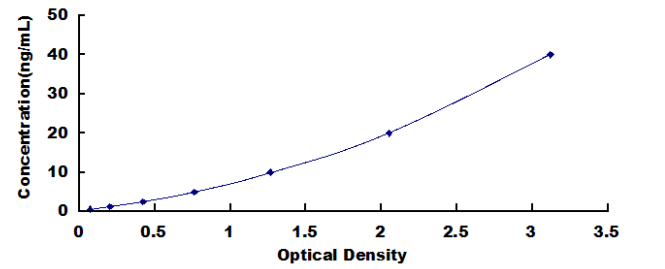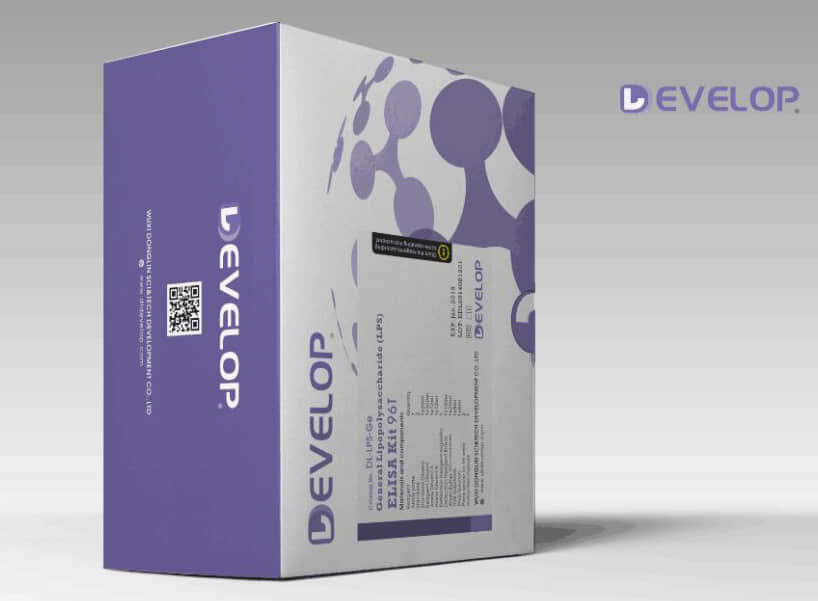Human Tolloid Like Protein 1 (TLL1) ELISA Kit


two product lines: Traditional ELISA Kit and Ready-to-Use ELISA Kit.


Other names:
Function: Protease which processes procollagen C-propeptides, such as chordin, pro-biglycan and pro-lysyl oxidase. Required for the embryonic development. Predominant protease, which in the development, influences dorsal-ventral patterning and skeletogenesis.
Sequence:
MGLGTLSPRM LVWLVASGIV FYGELWVCAG LDYDYTFDGN EEDKTETIDY
60 70 80 90 100
KDPCKAAVFW GDIALDDEDL NIFQIDRTID LTQNPFGNLG HTTGGLGDHA
110 120 130 140 150
MSKKRGALYQ LIDRIRRIGF GLEQNNTVKG KVPLQFSGQN EKNRVPRAAT
160 170 180 190 200
SRTERIWPGG VIPYVIGGNF TGSQRAMFKQ AMRHWEKHTC VTFIERSDEE
210 220 230 240 250
SYIVFTYRPC GCCSYVGRRG NGPQAISIGK NCDKFGIVVH ELGHVIGFWH
260 270 280 290 300
EHTRPDRDNH VTIIRENIQP GQEYNFLKME PGEVNSLGER YDFDSIMHYA
310 320 330 340 350
RNTFSRGMFL DTILPSRDDN GIRPAIGQRT RLSKGDIAQA RKLYRCPACG
360 370 380 390 400
ETLQESNGNL SSPGFPNGYP SYTHCIWRVS VTPGEKIVLN FTTMDLYKSS
410 420 430 440 450
LCWYDYIEVR DGYWRKSPLL GRFCGDKLPE VLTSTDSRMW IEFRSSSNWV
460 470 480 490 500
GKGFAAVYEA ICGGEIRKNE GQIQSPNYPD DYRPMKECVW KITVSESYHV
510 520 530 540 550
GLTFQSFEIE RHDNCAYDYL EVRDGTSENS PLIGRFCGYD KPEDIRSTSN
560 570 580 590 600
TLWMKFVSDG TVNKAGFAAN FFKEEDECAK PDRGGCEQRC LNTLGSYQCA
610 620 630 640 650
CEPGYELGPD RRSCEAACGG LLTKLNGTIT TPGWPKEYPP NKNCVWQVVA
660 670 680 690 700
PTQYRISVKF EFFELEGNEV CKYDYVEIWS GLSSESKLHG KFCGAEVPEV
710 720 730 740 750
ITSQFNNMRI EFKSDNTVSK KGFKAHFFSD KDECSKDNGG CQHECVNTMG
760 770 780 790 800
SYMCQCRNGF VLHDNKHDCK EAECEQKIHS PSGLITSPNW PDKYPSRKEC
810 820 830 840 850
TWEISATPGH RIKLAFSEFE IEQHQECAYD HLEVFDGETE KSPILGRLCG
860 870 880 890 900
NKIPDPLVAT GNKMFVRFVS DASVQRKGFQ ATHSTECGGR LKAESKPRDL
910 920 930 940 950
YSHAQFGDNN YPGQVDCEWL LVSERGSRLE LSFQTFEVEE EADCGYDYVE
960 970 980 990 1000
LFDGLDSTAV GLGRFCGSGP PEEIYSIGDS VLIHFHTDDT INKKGFHIRY
1010
KSIRYPDTTH TKK
INTENDED USE
The kit is a sandwich enzyme immunoassay for the in vitro quantitative measurement of TLL1 in human serum, plasma, tissue homogenates or other biological fluids.
DETECTION RANGE
0.625-40ng/mL. The standard curve concentrations used for the ELISA’s were 40ng/mL, 20ng/mL, 10ng/mL, 5ng/mL, 2.5ng/mL, 1.25ng/mL, 0.625ng/mL.
SENSITIVITY
The minimum detectable dose of TLL1 is typically less than 0.216ng/mL.
The sensitivity of this assay, or Lower Limit of Detection (LLD) was defined as the lowest protein concentration that could be differentiated from zero. It was determined by adding two standard deviations to the mean optical density value of twenty zero standard replicates and calculating the corresponding concentration.
SPECIFICITY
This assay has high sensitivity and excellent specificity for detection of TLL1.
No significant cross-reactivity or interference between TLL1 and analogues was observed.
You can reference link of the kit as following
https://dldevelop.com/Research-reagent/dl-tll1-hu.html
https://www.dldevelop.com/uploadfile/data/DL-TLL1-Hu.pdf
Introduction
| Item | Standard | Test | |
| Description |
The kit is a sandwich enzyme immunoassay for the in vitro quantitative measurement of TLL1 in human serum, plasma, tissue homogenates and other biological fluids. |
Conform | |
| Identification | Colorimetric | Positive | |
| Composition | Traditional ELISA Kit | Ready-to-Use ELISA KIT | Conform |
| Pre-coated, ready to use 96-well strip plate 1 | Pre-coated, ready to use 96-well strip plate 1 | ||
| Plate sealer for 96 wells 2 | Plate sealer for 96 wells 2 | ||
| Standard 2 | Standard 2 | ||
| Diluents buffer 1×45mL | Standard Diluent 1×20mL | ||
| Detection Reagent A 1×120μL | Detection Solution A 1×12mL | ||
| Detection Reagent B 1×120μL | Detection Solution B 1×12mL | ||
| TMB Substrate 1×9mL | TMB Substrate 1×9mL | ||
| Stop Solution 1×6mL | Stop Solution 1×6mL | ||
| Wash Buffer (30 × concentrate) 1×20mL | Wash Buffer (30 × concentrate) 1×20mL | ||
| Instruction manual 1 | Instruction manual 1 | ||
Test principle
The microtiter plate provided in this kit has been pre-coated with an antibody specific to TLL1. Standards or samples are then added to the appropriate microtiter plate wells with a biotin-conjugated antibody preparation specific to TLL1. Next, Avidin conjugated to Horseradish Peroxidase (HRP) is added to each microplate well and incubated. After TMB substrate solution is added, only those wells that contain TLL1, biotin-conjugated antibody and enzyme-conjugated Avidin will exhibit a change in color. The enzyme-substrate reaction is terminated by the addition of sulphuric acid solution and the color change is measured spectrophotometrically at a wavelength of 450nm ± 10nm. The concentration of TLL1 in the samples is then determined by comparing the O.D. of the samples to the standard curve.
Recovery
Matrices listed below were spiked with certain level of recombinant TLL1 and the recovery rates were calculated by comparing the measured value to the expected amount of TLL1 in samples.
| Matrix | Recovery range (%) | Average(%) |
| serum(n=5) | 80-102 | 91 |
| EDTA plasma(n=5) | 81-99 | 90 |
| heparin plasma(n=5) | 80-89 | 84 |
Linearity
The linearity of the kit was assayed by testing samples spiked with appropriate concentration of TLL1 and their serial dilutions. The results were demonstrated by the percentage of calculated concentration to the expected.
| Sample | 1:2 | 1:4 | 1:8 | 1:16 |
| serum(n=5) | 87-91% | 87-107% | 74-101% | 92-97% |
| EDTA plasma(n=5) | 90-105% | 84-101% | 90-101% | 79-108% |
| heparin plasma(n=5) | 84-95% | 92-105% | 82-105% | 89-91% |
Precision
Intra-assay Precision (Precision within an assay): 3 samples with low, middle and high level TLL1 were tested 20 times on one plate, respectively.
Inter-assay Precision (Precision between assays): 3 samples with low, middle and high level TLL1 were tested on 3 different plates, 8 replicates in each plate.
CV(%) = SD/meanX100
Intra-Assay: CV<10%
Inter-Assay: CV<12%
Stability
The stability of ELISA kit is determined by the loss rate of activity. The loss rate of this kit is less than 5% within the expiration date under appropriate storage conditions.
Note:
To minimize unnecessary influences on the performance, operation procedures and lab conditions, especially room temperature, air humidity and incubator temperatures should be strictly regulated. It is also strongly suggested that the whole assay is performed by the same experimenter from the beginning to the end.
Assay procedure summary
1. Prepare all reagents, samples and standards;
2. Add 100µL standard or sample to each well. Incubate 2 hours at 37℃;
3. Aspirate and add 100µL prepared Detection Reagent A. Incubate 1 hour at 37℃;
4. Aspirate and wash 3 times;
5. Add 100µL prepared Detection Reagent B. Incubate 1 hour at 37℃;
6. Aspirate and wash 5 times;
7. Add 90µL Substrate Solution. Incubate 15-25 minutes at 37℃;
8. Add 50µL Stop Solution. Read at 450nm immediately.
Order or get a Quote
We will reply you within 24 hours!














